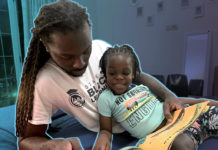I can’t speak for other moms, but more than I care about my daughter being top of her class, I care about her learning to be a respectful citizen of the world. That means showing respect to her teachers, sitting with the kid that usually sits alone, and standing up to or simply tuning out the mean girls. That also means demanding respect while encouraging others to use their voices and actions to do the same!
Respect is my human right. You don’t have to like me, but you WILL respect me as I respect you. All any human being wants is the right to not be treated as “less than,” to feel safe and supported for being exactly who they are.
That person could be a child in your classroom, family, household, or a stranger yet to cross your path, but our children are always there absorbing what we model. In order for the generation we are raising to continue to enact change, our voices and actions must first be a mirror of what we wish them to reflect. So I allow this one simple promise to guide me: ”I will not teach my children to hate your children.”
Often times, as adults raised in the ’70s and the ’80s, where a certain ideal or picture of a nuclear family was still being framed in a particular way, we struggle with where to begin with approaching the topics involved with Pride month.
It’s important to try to look at a situation for children, with children’s eyes and suddenly things aren’t so complex anymore. Children think in broad strokes and many shades of gray until we step in to define those black and whites for them. So when addressing Pride month, let’s start with the very concept of pride.
Pride itself is a consciousness of one’s own dignity; a feeling of one’s own achievements or sense of self. This emotion isn’t as easy to pin down for most children as happy, mad, or sad may be. As adults, some of us still struggle with both internalizing and expressing pride making it all the more confusing for our kids to. That being said, where do I start?
Well, my daughter is 7, and she actually introduced me to a cartoon TV show she loves called “Steven Universe.” Her older preteen cousins watched a little with her, and being the mom I am, wanted to get involved with the show and see what it was all about. As it progressed, I realized it was very pro-love, and celebrated connections over magnifying differences.
One of the main characters was actually two separate characters fused together. As my daughter explained it, “Look mommy the are actually joined because they love each other so much they like to be connected more than separated.”
The two characters eventually separate in a later episode and happen to both be girls who do in fact share a powerful loving bond. There was even a wedding episode. I kept waiting for her to be confused, or ask for clarity, instead she just accepted their love and their connection. She was touched by their relationship and that made me so proud.
My point is, the world around our children from TV, to the kid in their class with two dads, to their own feelings are presenting an evolved picture of inclusion for them everyday. Our only real job is to catch up and when asked for clarity keep these tips in mind:
- Be Intentional With Your Language and Actions
Our words and how we express ourselves show children what we value and model for them how they should participate in the world. - Amplify That at The Heart of It All is PRIDE and LOVE
Move from defining these things as best we can (with examples of friendship, romance, family), to normalizing differences, then to validating/accepting that someone else’s difference is no more right/wrong than their own differences, finally channeling that acceptance into a celebration of the differences. - Remember Resources, Visuals, and Personal Experience Matter
Especially when attempting to get abstract concepts to take tangible root with children.
Here are a few teacher suggested texts to aid your discussion, combat gender stereotypes, and introduce pride positive stories to your young children.
Little Bee Books is a website proud to showcase products and books published in partnership with GLAAD series.
An original version of this piece appeared on The Classroom Mom.










